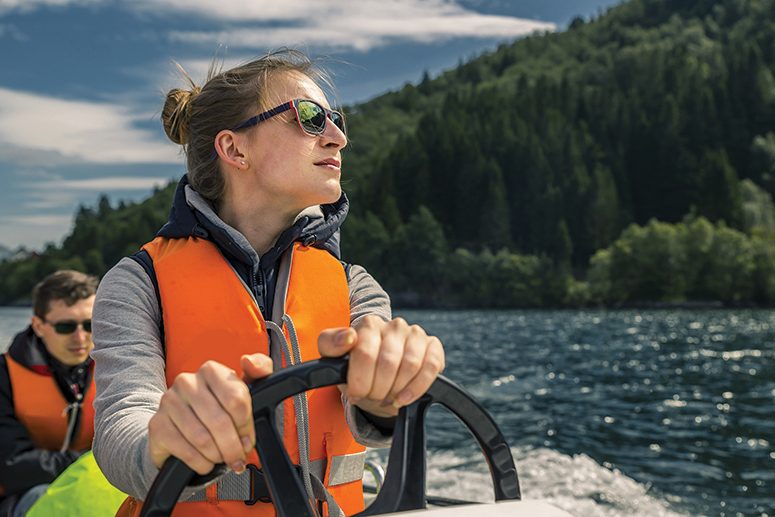Hazards of Specific Modes of Travel

Plane crashes and shipwrecks make headlines, but the chances of experiencing such events are minuscule. Travelers can, however, plan for the more common hazards associated with various modes of travel.
Plane Travel
Flying exposes travelers to high altitudes, a decreased level of oxygen, relatively quick atmospheric pressure changes during ascent and descent, very dry air, and proximity to other travelers who may have transmissible diseases. While you should always be on guard against respiratory infections, it is especially important to follow public health recommendations at times of outbreaks and take care of personal protection. When planning travel by airplane, check with your air carriers and the U.S. Centers for Disease Control and Prevention (CDC) for current guidelines.
Major passenger airliners typically cruise at an altitude of 36,000 feet while maintaining cabin pressure at a level equivalent to 5,000 to 8,000 feet, which is roughly 15 percent to 25 percent less than sea-level atmospheric pressure. The oxygen in cabin air is proportionally reduced, affecting people with severe lung, heart or circulatory diseases. People with such conditions should consult their physicians before traveling by air.
During ascent or descent, cabin pressure changes relatively quickly. If gas cannot move freely in or out of your middle ears and sinus cavities, a pressure differential may occur, which can cause pain or discomfort in your ears or sinuses or in rare instances can rupture your eardrum. It is important to remain awake during ascent and descent so you can actively equalize your ears’ pressure (see DAN.org/Health/Ears). If you are congested or suffer from excessive postnasal drip, consider taking an over-the-counter or prescription decongestant to help keep open your sinus passages and improve your ability to equalize middle-ear pressure.
Long international flights can cause fatigue. The more time zones you cross, the more likely you will experience jet lag (see Section 2). Other contributors to heightened fatigue include the noise level on a plane, dryness of the cabin air, irritants that may be present in the cabin environment and the physical inactivity resulting from long flight. Avoiding alcohol and caffeine and using a sleep aid may help mitigate this problem. Try to build extra time into your schedule for rest after a flight through multiple time zones.
Sitting in a cramped airplane seat for a long time may cause some travelers to develop a severe condition known as deep vein thrombosis (DVT) or blood clots in the legs (see Section 2).
Billions of people fly each year, so just about any kind of medical emergency may occasionally occur on a plane. An estimated 24 to 130 in-flight emergencies occur per 1 million passengers.11 If an incident does occur in flight, crew members have some first aid training but are not medical professionals, and they have limited equipment available to them. They usually depend on remote medical assistance through a service such as MedAire (MedAire.com), which provides medical advisory services to airlines worldwide.
Some airline personnel check for visibly sick passengers in their waiting areas and during the boarding process. If you look like you may be sick, you may not be permitted to board the plane.
If you get sick while you are on a plane, note the following:
- Tell a crew member as soon as possible.
- If you cough, you will be asked to wear a surgical mask or cover your mouth and nose.
- If your illness is severe, crew members may move you to a different part of the plane or, if necessary, have the plane rerouted to the nearest airport so you can deplane there and be transported to a medical facility.
Motor Vehicle Travel
Motor vehicle accidents are the primary cause of disability or loss of life among travelers. A variety of factors contribute to these accidents, most of which can be prevented or diminished. Primary among these factors is seat belt usage.
If you plan to drive, reduce your accident risk by familiarizing yourself with local traffic laws and patterns before getting behind the wheel. Be aware that locals’ observation of traffic laws in some regions may be limited. Know which side of the road to drive on, and plan ahead so you know the routes you’ll be taking. Most smartphones have GPS chips, and apps are available with preloaded maps that could be a great resource without needing to use an international cellular data plan.
The risks of a motor vehicle accident are likely greatest in developing nations due to poor road infrastructure, the disrepair of many vehicles, a modest culture of safety and limited or inaccessible medical care. Remote locations may not have local emergency medical services or a level of care sufficient to meet the needs of a seriously injured traveler. Screening of blood supplies and sterilization of instruments and needles may also be inadequate. Remote regions of the world have their appeal, but consider these drawbacks as you make your travel plans.
The most important action that travelers can take with motor vehicles is to wear seat belts in cars and helmets on motorcycles and scooters. They really do save lives.

Boat Travel
Marine travel involves some general hazards as well as ones specific to certain types of vessels, destinations and activities. The majority of seagoing travelers are aboard either large cruise ships or small recreational boats or liveaboards.
Cruise ships: Cruise ships have their own onboard health hazards independent of the destination, often providing extended exposure to other passengers and the crew, who have likely come from all parts of the world and may be carrying potentially communicable diseases. Outbreaks of COVID-19, chickenpox and rubella (German measles), for example, have occurred on cruise ships.
A common shipboard outbreak is vomiting and diarrhea caused by noroviruses. Respiratory infections and foodborne poisonings are also common as are lifestyle disorders due to dietary changes, overeating and excessive alcohol consumption.
Regardless of your itinerary, make sure you are up to date on all necessary or recommended vaccinations for diseases including but not limited to measles/mumps/rubella, varicella (chicken pox), tetanus, seasonal flu and pneumonia.

Cruise ship hazards that are related to being on a moving platform include motion sickness, falls that result in injuries and falls overboard that result in drowning.
If you are sick or injured while on a cruise ship, note the following:
- Tell a crew member as soon as possible.
- Cruise ships usually have a small medical facility on board
where your illness may be treated. - If your illness is serious, the medical staff may stabilize your condition
and move you to a hospital on land for further treatment.
Medical evacuation at sea is complex, hazardous and expensive. Consider your health before you go on a cruise, and be sure to purchase insurance that covers medical evacuation, which is not covered by standard health insurance policies or Medicare.
Recreational vessels: Health concerns for recreational boaters include injury, acute illness and other travel-related diseases. The American Boating Association reports that in 2019 almost 12 million recreational vessels were registered in the United States. That year the U.S. Coast Guard logged 4,168 marine accidents, which involved 2,559 mandatory reportable injuries and 613 deaths. Little data are available about the nature of the nonfatal injuries, but most of the fatal injuries occurred on small vessels of 21 feet or less, including open motorboats, canoes and kayaks. Drowning was the cause of death in 79 percent of fatal boating accidents; trauma or hypothermia were among the other causes. Of those who drowned, 86 percent were not wearing a life jacket.14
Alcohol use is a major contributing factor in boating accidents and is the leading factor in 23 percent of deaths. Other common risk factors include operator inattention, improper lookout, operator inexperience and excessive speed.15 Take steps to minimize or eliminate these factors whenever you set sail.
The most important thing boaters can do is to wear life jackets.
They save lives.


Long international flights can cause fatigue. The more time zones you cross, the more likely you will experience jet lag … Avoiding alcohol and caffeine and using a sleep aid may help mitigate this problem.

Motor Vehicle
Accidents
Every year, 20 million to 50 million people worldwide are injured and 1.3 million are killed in motor vehicle crashes.
— 90 percent of these casualties occur in developing countries.
— 25,000 of the deaths are among tourists.
Road-related accidents are the No. 1 cause of preventable death among healthy American travelers.
Nearly half of medical evacuations tothe United States are the result of a car crash.
A medical evacuation can cost more than $100,000.
Source: Sauber-Schatz et al. 201912
Eight Simple Steps
to Minimize Your
Risk of Motor
Vehicle Accidents
- Always wear a seat belt and put children in car seats.
- Avoid riding motorcycles. If you must ride a motorcycle, wear a helmet and body protection.
- Do not drink and drive.
- Be alert when crossing the street, especially in countries where people drive on the other side of the road.
Source: U.S. Centers for Disease Control
and Prevention13


The most important
thing boaters can do
is to wear life jackets.
They save lives.
DAN Customer Service
Mon–Fri, 8:30 a.m. – 5 p.m. ET
+1 (919) 684-2948
+1 (800) 446-2671
Fax: +1 (919) 490-6630
24/7 Emergency Hotline
In event of a dive accident or injury, call local EMS first, then call DAN.
24/7 Emergency Hotline:
+1 (919) 684-9111
(Collect calls accepted)
DAN must arrange transportation for covered emergency medical evacuation fees to be paid.
Medical Information Line
Get answers to your nonemergency health and diving questions.
Mon–Fri, 8:30 a.m. – 5 p.m. ET
+1 (919) 684-2948, Option 4
Online: Ask A Medic
(Allow 24-48 hours for a response.)